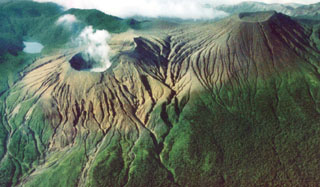Report on Rincon de la Vieja (Costa Rica) — 7 June-13 June 2017
Smithsonian Institution / US Geological Survey
Weekly Volcanic Activity Report, 7 June-13 June 2017
Managing Editor: Sally Sennert.
Please cite this report as:
Global Volcanism Program, 2017. Report on Rincon de la Vieja (Costa Rica) (Sennert, S, ed.). Weekly Volcanic Activity Report, 7 June-13 June 2017. Smithsonian Institution and US Geological Survey.
Rincon de la Vieja
Costa Rica
10.8314°N, 85.3364°W; summit elev. 1729 m
All times are local (unless otherwise noted)
OVSICORI-UNA reported that a small, minute-long, phreatic eruption in Rincón de la Vieja's crater lake began at 0542 on 11 June. Poor visibility prevented visual confirmation of plume details, though the Washington VAAC reported that a thermal anomaly was present in satellite images. A small seismic signal that lasted less than one minute was recorded at 2106 on 12 June. The signal possibly represented an emission, though it was not confirmed.
Geological Summary. Rincón de la Vieja is a volcanic complex in the Guanacaste Range of NW Costa Rica. Sometimes referred to as the Rincon de la Vieja-Santa María Volcanic Complex, it consists of a slightly arcuate 20-km-long ridge of 12 craters and pyroclastic cones constructed within the 15-km-wide early Pleistocene Guachipelín caldera, whose rim is exposed on the south side. Sometimes known as the "Colossus of Guanacaste," it has an estimated volume of 130 km3 and contains at least nine major eruptive centers. The Santa María cone, the highest peak of the complex, is located on the E side of the ridge and has a lake within the 400-m-diameter crater. A Plinian eruption producing the 0.25 km3 Río Blanca tephra about 3,500 years ago was the last major magmatic eruption. All subsequent eruptions, including numerous reported eruptions possibly dating back to the 16th century, have been from the active crater, near the center of the complex, with an acidic 300-m-diameter lake.
Sources: Observatorio Vulcanologico y Sismologico de Costa Rica-Universidad Nacional (OVSICORI-UNA), Washington Volcanic Ash Advisory Center (VAAC)

